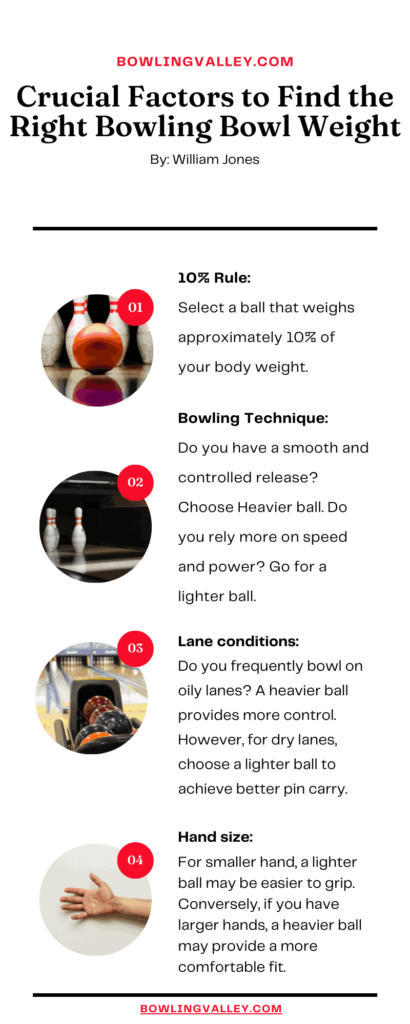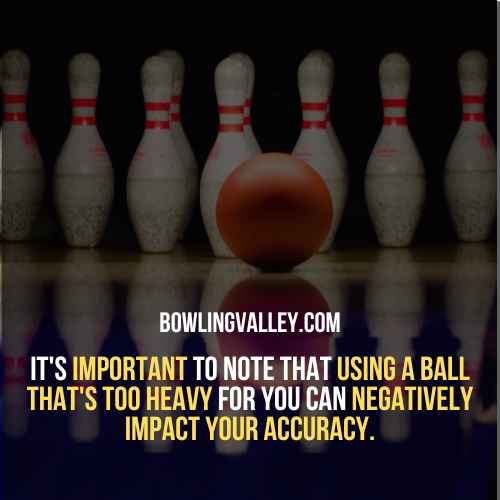I know how it feels when you are tired of guessing “which bowling ball weight should I use?” Well, No more frustration or confusion!
Besides 4 crucial factors, today I will reveal the roadmap to finding the perfect bowl weight for your bowling game.
So sit back, relax, and get ready to make strikes with ease.
Jump to a Specific Section
Quick Go Through – Key Points for Finding the Right Bowling Ball Weight
– The 10% Rule suggests selecting a ball that weighs approximately 10% of your body weight.
– Initially opting for a lighter ball can offer advantages such as improved control and reduced risk of injury.
– A heavier ball can increase pin action and generate more power, but it’s important to find the right weight based on body strength and bowling style.
– Custom fitted bowling balls increase control and improve ball reaction, leading to better performance on the lanes.
4 Crucial Factors to Choose Right Bowling Ball Weight
Besides physical fitness and strength there are several other key factors that can impact your performance on the lanes:

1. The 10% Rule
This rule suggests that you should aim to select a ball that weighs approximately 10% of your body weight.
By adhering to this guideline, you can experience a range of benefits that will enhance your bowling performance.
2. Bowling Technique:
Your bowling technique plays a significant role in determining the ideal ball weight for you.
If you have a smooth and controlled release, you may be able to handle a heavier ball. On the other hand, if you rely more on speed and power, a lighter ball may be more suitable.
3. Lane Conditions:
The condition of the lanes can vary greatly from one bowling alley to another. If you frequently bowl on oily lanes, a heavier ball may provide more control.
However, if you often encounter dry lanes, a lighter ball may help you achieve better pin carry.
4. Hand Size:
The size of your hand can also influence the optimal weight for your bowling ball. If your hand is smaller, a lighter ball may be easier to grip and control.
Conversely, if you have larger hands, a heavier ball may provide a more comfortable fit.
Okay, now you have read all these general factors but here is my …
Beginner’s Roadmap to Find the Right Bowling Bowl Weight

One of these misconceptions is that a heavier ball will always lead to better performance.
While it can provide benefits, it’s important to note that using a ball that’s too heavy for you can negatively impact your accuracy.
It may cause you to lose control and hinder your ability to consistently hit your desired target.
The key is to start with a lighter bowling ball and gradually increase the weight.
Why so?
This approach allows you to develop proper technique, build physical strength, increase ball speed, adapt to your bowling style, and prevent injuries.
Let’s understand the importance of this transition once and for all.
Advantages of Using Lighter Bowling Balls (Initially)
- Injury prevention is a significant concern for any bowler.
Starting with a lighter ball reduces the risk of strain or injury, allowing you to focus on your technique and gradually build up your strength.
It can also reduce the risk of injury, as it places less strain on your arm and shoulder muscles.
- When it comes to proper technique, using a lighter bowling ball allows you to focus on the fundamentals.
You can work on your approach, release, and follow-through without feeling overwhelmed by the weight of the ball.
- Ball speed is crucial in bowling. By starting with a lighter ball, you can work on increasing your speed without sacrificing accuracy.
As you progress and gain more control, you can gradually move up to a heavier ball that complements your increased speed.
- Your bowling style also plays a role in determining the right ball weight for you. Different styles require different amounts of control and power.
Starting with a lighter ball allows you to fine-tune your style and make adjustments as necessary.
As you become more comfortable, you can experiment with different ball weights to find the one that suits your style best.
However, it’s essential to strike a balance, as using a ball that’s too light may result in a lack of power and reduced pin action.
As you become more comfortable and confident, you can gradually move up to a heavier ball, ensuring that your technique remains solid.
Finally, by transitioning from lighter to heavy bowls, you would be able to enjoy …
The Advantages of Using Heavy Bowling Bowl:
Firstly, it allows for increased pin action, resulting in a greater chance of knocking down more pins with each throw.
Additionally, a heavier ball can generate more power, leading to a higher bowling speed and improved overall performance.
Till now you have understood the roadmap for choosing the right bowl weight.
But, what if you go to the pro shop and get confused by the types of balls?
So, let’s explore the different types of bowling ball weights.
By this way, you can make an informed decision and improve your overall performance on the lanes.
Different Types of Bowling Ball and Their Weights
When it comes to bowling ball weights, there are three main categories to consider: the house ball, the performance ball, and the specialty ball.
Each of these weights offers different benefits and advantages depending on your skill level and playing style.
- House balls:
House balls are the balls that are available to use at most bowling centers. They are typically made of plastic or polyester and weigh between 6 and 16 pounds.
These characteristics makes them a good option for beginners because they are relatively inexpensive and easy to find.
- Performance balls:
Performance balls are made of more durable materials, such as urethane or reactive resin. They are also more expensive than house balls.
These are available in a variety of weights, but they are most commonly found in weights between 12 and 16 pounds. Performance balls are a good option for more experienced bowlers who want more control and power over their shots.
- Specialty balls:
Specialty balls are designed for specific purposes, such as hitting certain types of pins or bowling on different types of lane conditions.
These balls are available in a variety of weights and materials, typically ranging from 12 to 16 pounds.
Such characteristics makes them a good option for advanced bowlers who want to fine-tune their game.
Quick Recap – “Which Bowling Ball Weight Should I Use?”
In a nutshell, choosing the right bowling ball weight is essential for improving your bowling performance.
The 10% Rule is a good starting point, but it’s important to consider other factors such as your bowling technique, lane conditions, hand size, and bowling style. (as discussed earlier in detail)
If you’re a beginner, it’s best to start with a lighter ball and gradually increase the weight as you become more experienced and stronger.
This will allow you to develop proper technique, build physical strength, increase ball speed, adapt to your bowling style, and prevent injuries.
Once you’ve found a ball weight that feels comfortable and allows you to bowl consistently, you can start to experiment with different materials and coverstocks to find a ball that suits your playing style and the lane conditions you typically bowl on.
Here are some additional tips for choosing the right bowling ball weight:
- If you’re unsure which weight to start with, ask a bowling pro for help. They can assess your bowling technique and recommend a ball weight that is appropriate for you.
- Try out different ball weights before you buy one. Most bowling centers have a variety of house balls that you can try for free.
- Don’t be afraid to increase ball weights as you improve. As you get stronger and more experienced, you may be able to handle a heavier ball.
By following this process of finding the right ball weight, you’ll be well on your way to improving your bowling game and knocking down more pins.
Good luck!
Resources Used to Provide Authentic and Up to Date Information:
Psychological and psychomotor skills associated with prowess at ten‐pin bowling
